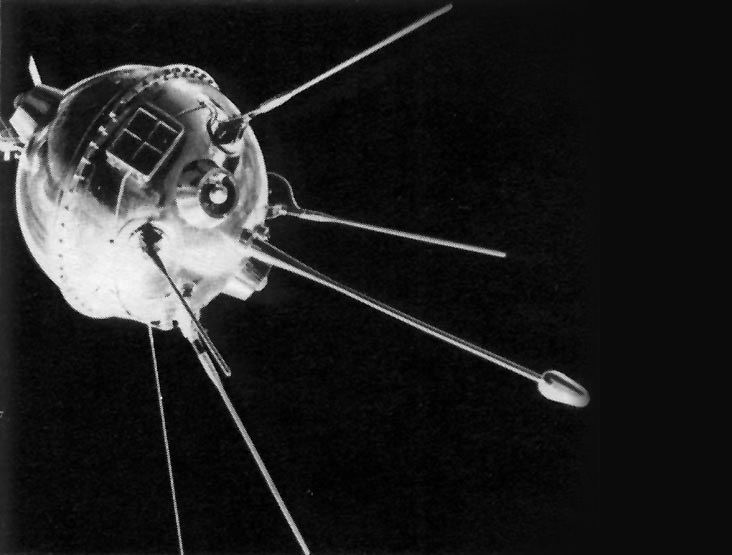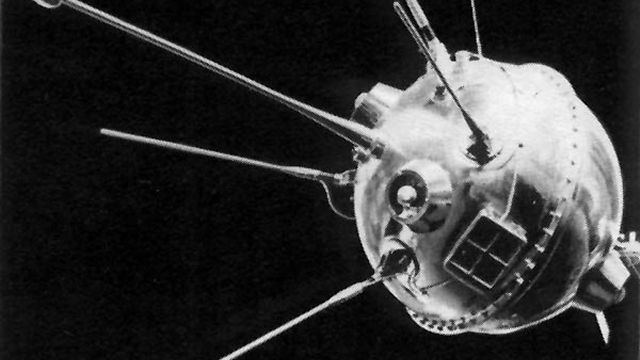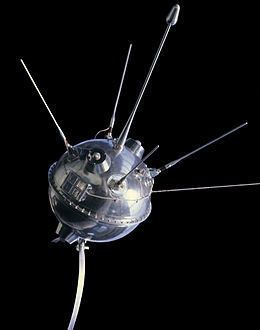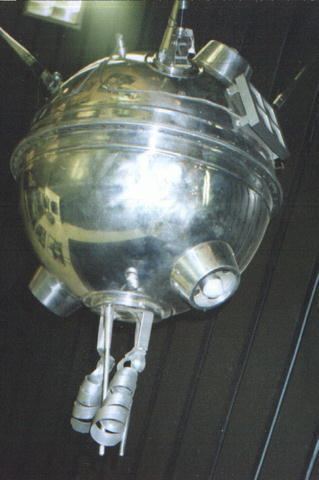Mission type Lunar impactor Harvard designation 1959 Mu 1 Launch mass 361 kilograms (796 lb) Max speed 8,900 km/h Launch date 2 January 1959 | SATCAT no. 112 Reference system Heliocentric Period 1.2 years Cost 4.5 billion USD | |
 | ||
Manufacturer S. P. Korolev Rocket and Space Corporation Energia Similar | ||
Luna 1, also known as Mechta (Russian: Мечта, lit.: Dream), E-1 No.4 and First Lunar Rover , was the first spacecraft to reach the vicinity of the Earth's Moon, and the first spacecraft to be placed in heliocentric orbit. Intended as an impactor, Luna 1 was launched as part of the Luna programme in 1959, however due to an incorrectly timed upper stage burn during its launch, it missed the Moon; in the process becoming the first spacecraft to leave geocentric orbit.
Contents

While traveling through the outer Van Allen radiation belt, the spacecraft's scintillator made observations indicating that a small number of high energy particles exist in the outer belt. The measurements obtained during this mission provided new data on the Earth's radiation belt and outer space. The Moon was found to have no detectable magnetic field. The first ever direct observations and measurements of the solar wind, a strong flow of ionized plasma emanating from the Sun and streaming through interplanetary space, were performed. That ionized plasma concentration was measured to be some 700 particles per cm3 at altitudes 20–25 thousand km and 300 to 400 particles per cm3 at altitudes 100–150,000 km. The spacecraft also marked the first instance of radio communication at the half-million-kilometer distance.

A malfunction in the ground-based control system caused an error in the rocket's burntime, and the spacecraft missed the target and flew by the Moon at a distance of 5,900 km at the closest point. Luna 1 then became the first man-made object to reach heliocentric orbit and was then dubbed a "new planet" and renamed Mechta (Dream). Luna 1 was also referred to as the "First Cosmic Rocket", in reference to its achievement of escape velocity.

1959 luna 1 ussr
Spacecraft

Luna 1 contained radio equipment including a tracking transmitter and telemetry system, and five instruments to study the Moon and interplanetary space; including a magnetometer, geiger counter, scintillation counter, and micrometeorite detector.

Luna 1 was designed to impact the Moon, delivering two metallic pennants with the Soviet coat of arms that were included into its package. This mission was eventually accomplished by Luna 2.
Launch

Luna 1 was launched at 16:41 GMT (22:41 local time) on 2 January 1959 from Site 1/5 at the Baikonur Cosmodrome by a Luna 8K72 rocket. Luna 1 became the first man-made object to reach the escape velocity of the Earth, along with its carrier rocket's 1,472-kilogram (3,245 lb) upper stage, which it separated from after achieving heliocentric orbit.
Due to a programming error, the duration of the upper stage's burn was incorrect, and consequently Luna 1 failed to impact the Moon. The spacecraft passed within 5,995 kilometres (3,725 mi) of the Moon's surface on 4 January after 34 hours of flight. It remains in orbit around the Sun, between the orbits of Earth and Mars.
Sodium release experiment
At 00:56:20 UTC on 3 January, at a distance of 119,500 kilometres (74,300 mi) from Earth, 1 kilogram (2.2 lb) of sodium gas was released by the spacecraft, forming a cloud behind it to serve as an artificial comet. This glowing orange trail of gas, visible over the Indian Ocean with the brightness of a sixth-magnitude star for a few minutes, was photographed by Mstislav Gnevyshev at the Mountain Station of the Main Astronomical Observatory of the Academy of Sciences of the USSR near Kislovodsk. It served as an experiment on the behavior of gas in outer space.
A wired press photograph entitled "Rockets / Russian rocket sent into outer space January 1959 (first rocket fired at moon)" Describes how the Sodium gas cloud was photographed by Mr Morris Alan, the following text is taken verbatim from the reverse of a press photograph stamped Kemsley Newspapers 6 Jan 1959.
"The Russian rocket on its way to the moon. Mr Morris Alan, 34 year old freelance photographer, who was the first man to photograph the original Russian Sputnik, early this morning took this photograph of the moon rocket. He and his three assistants saw the rocket from Kingscat Hill, near Dunfermline, Firthshire, just after 1 AM and held it in view for almost eight minutes. "It appeared like a cloud on the horizon near the constellation Virgo", he said. "We photographed it with three cameras and with a movie camera. It's emerged in the sky just over the horizon near Edinburgh, but it was a second or two before we realised what we had". The picture shows the lights of Edinburgh in the foreground. The rocket is seen as an illuminated cloud top centre."
Mr Morris Alan passed away on the 11th February 2015
Miscalculation
Luna 1 was meant to crash on the moon. However, a malfunction on the ground control system led the probe into missing its target by 5,995 kilometres; Luna 1 still managed to collect vital information to assist in our understanding of the universe.
